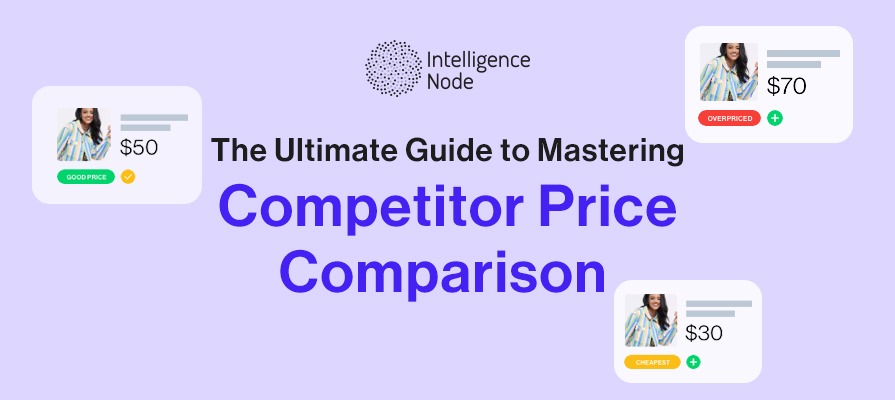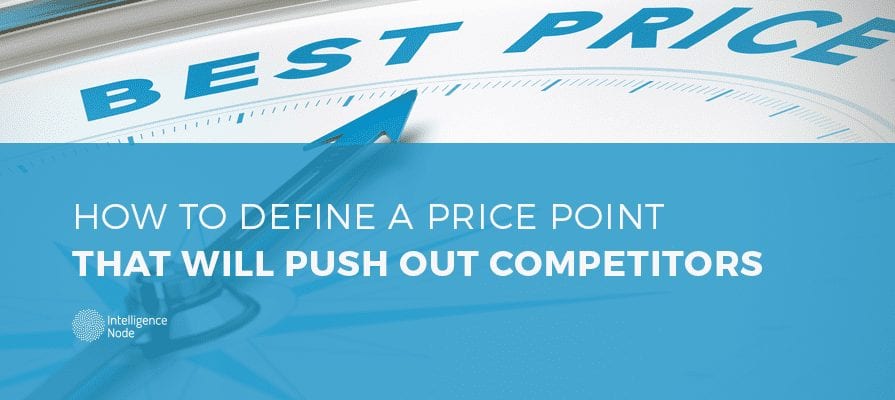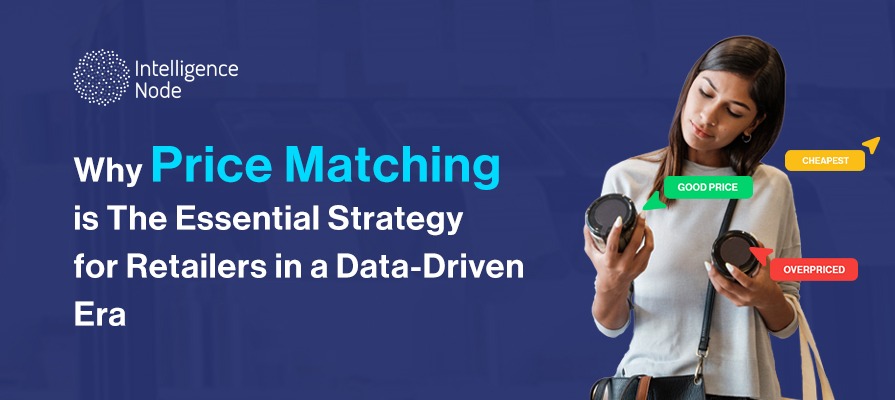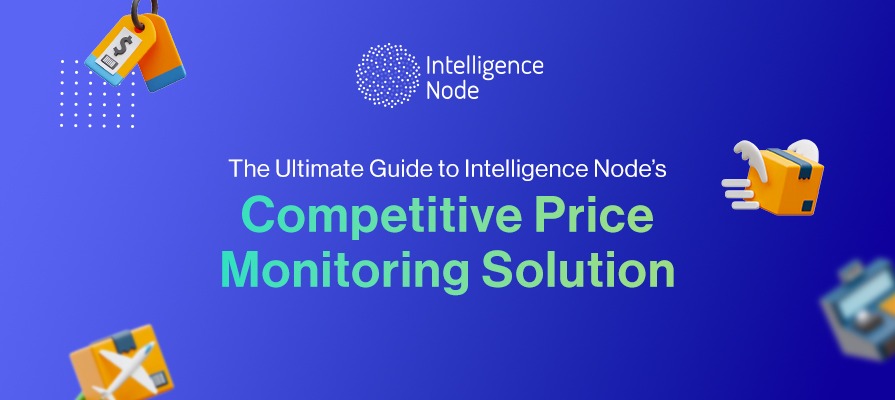The eCommerce landscape has become highly competitive with over 25 million online stores fighting for the attention of the same shoppers. Additionally, savvy shoppers use price comparison tools to compare prices across different online platforms and get the best deal for their purchases. How do brands and retailers keep up? How can they ensure they convert these shoppers? They can do this by tracking prices themselves with competitor pricing comparison solutions!
Key eCommerce Price Monitoring & Comparison Challenges
eCommerce pricing is highly nuanced and far more complicated than in-store pricing. The main reasons are the frequent price changes driven by online retailers and the sheer volume of data you need to monitor to make informed decisions. The rise of price monitoring tools and the growing online competition have made it challenging for brands and retailers to track and compare prices due to several factors. Some of them are:
1. Variant Level Product Matching
The first step to comparing prices is finding the right product matches that you want to review your prices against. This could be the exact products retailers and resellers sell, similar products that competitors offer, or variants (sizes, flavors, quantity) of identical products.
Without a robust product matching engine, brands and retailers often fail at this very first step. The matching products are either wrongly matched, have missing products, or showcase old data. A highly accurate, advanced product matching solution could resolve this challenge.
2. Large Volumes of Pricing Data
When comparing prices online, big retailers and brands need to track data across hundreds of thousands of SKUs sold on multiple retailer websites and marketplaces. With millions of products to track, the sheer volume of pricing data becomes overwhelming and analyzing it becomes a task. This leads to delayed, incomplete insights not suitable for accurate decision-making.
3. Manual Pricing Methods
In the digital age of retail, manual pricing solutions are holding retailers back. Gone are the days when prices were monitored once a quarter, and the number of SKUs to match against were in the hundreds. Today, online prices can be updated every few minutes. Additionally, retailers need to track and compare millions of SKUs. Manual price monitoring methods aren’t equipped to offer you this level of price comparison. Retailers need to employ automation and AI combined with human oversight to deploy pricing strategies that drive business efficiencies and that satisfy shoppers in tandem.
4. Inaccurate and Stale Data
A sizable challenge facing retailers and brands is the quality of the pricing data. A lot of price monitoring solutions promise to offer highly accurate, real-time data but fall short. Even if pricing solutions offer a data accuracy of 90%, it means that ten products out of 100 can be wrongly matched and compared. That’s a big number in the larger scheme of things. Hence, it is important for retailers to partner with price comparison solutions like Intelligence Node that offer a 99% data accuracy rate (written in our SLAs) and 10-second data refresh rates.
Here’s how competitor price comparison tools can help brands and retailers alleviate these challenges:
1. Get Visibility into Competitor Prices and Pricing Gaps
Making pricing decisions without data is like shooting hoops with blindfolds on. It’s going to be a miss almost every time. That’s precisely why having visibility into competitor prices is essential. Knowing how your competitor’s products are priced can help you establish and maintain competitive prices based on competitor’s price points.
2. Optimize Prices Based on Competitive Pricing Patterns
Besides helping you set and maintain competitive prices, competitor price comparison tools also enable you to optimize prices to take advantage of market movements. For example: you are offering a product at a discounted price to ensure higher sales. But in between the offer, you identify that your competitors have run out of stock for the same product. This information helps you manage prices in relation to supply and demand. Now, without a solution that offers visibility into competitor pricing movements, you would have continued giving these discounts and possibly losing margins unnecessarily.
3. Implement Smart Dynamic Pricing Strategies to Stay Competitive
Competitor price comparison solutions give you the data you need to implement rule-based dynamic pricing strategies that are more responsive to supply and demand. By comparing competitor prices at frequent intervals, you can react to price changes automatically with rule-based competitive dynamic pricing. You can set certain pricing rules like minimum price, maximum price, discount percentage, etc. to manage your pricing strategy.
4. Understand Historical Pricing Trends
Tracking competitor pricing over a period of time gives brands data to analyze pricing patterns and identify trends. These trends help retailers forecast future price movements. This can be especially useful during holiday shopping seasons and sales where there’s high traffic and buying intent.
5. Avoid Price Wars by Making Data-Driven Pricing Decisions
In a highly competitive eCommerce environment, price wars often become unavoidable to remain competitive and keep your sales up. But that does not have to be the case! Price wars are damaging for everyone and not sustainable in the long run. Avoiding these is possible with the right competitive pricing data at the right time. With accurate pricing information, retailers don’t need to resort to deep discounts. Instead, they can price products smartly based on the information available and remain competitive.
Seven Benefits of Using Automated Competitor Pricing Comparison Software
- Improved traffic & conversions
- Increased efficiency due to pricing based on supply and demand
- Reduced manhours
- Informed decision-making
- Accurate price tracking
- Improved consumer loyalty
- Reduced errors and costs
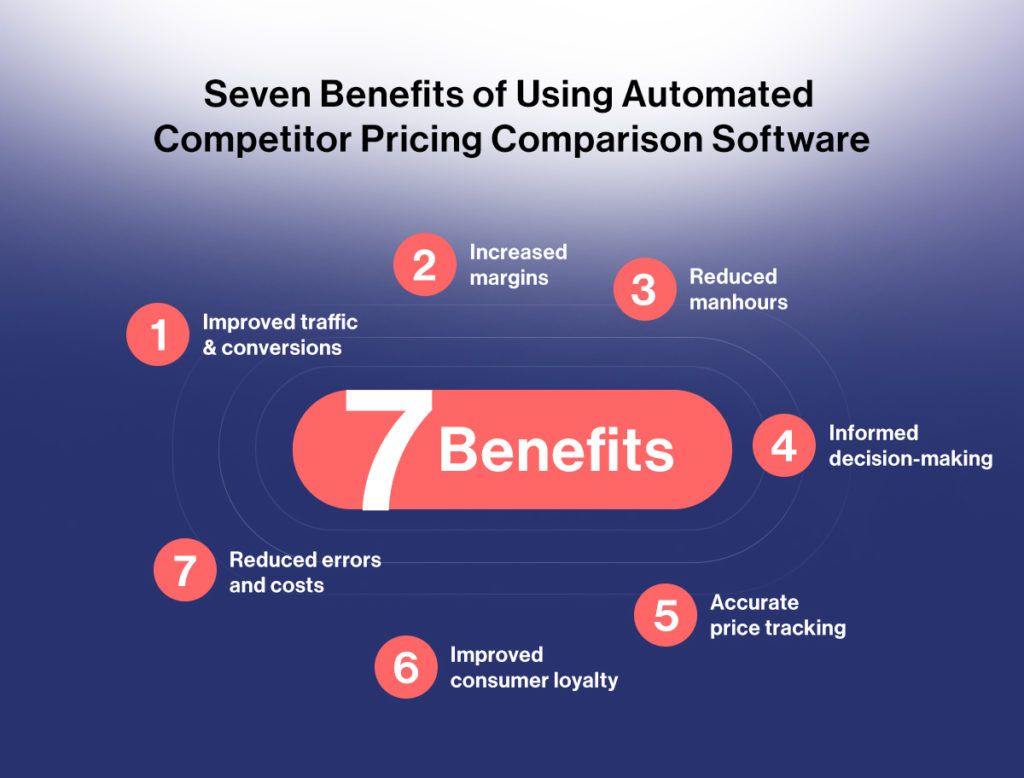
What to Look for in a Competitor Pricing Comparison Solution
- Data accuracy: When it comes to pricing, accuracy is key. Inaccurate data can lead to inadequate pricing decisions, ultimately affecting the bottom line. Find a solution that provides the most accurate competitor pricing.
- Data freshness: Adopt a tool that delivers data in near real-time so you have the latest pricing information to make informed decisions.
- Technology: Partner with a market leader when it comes to technology used. Find a vendor that incorporates the most cutting-edge AI and ML technology for intuitive and accurate analytics.
- Ease of implementation: Find a plug-and-play solution that can be implemented quickly, does not need integrations, and is easy to use.
- Automation: In the age of automation and AI, it is imperative that you opt for a solution that automates your daily tasks. This will free up your time for more strategic-level, impactful tasks.
Leveraging Intelligence Node’s Competitor Price Comparison Software
In the above section, we told you what to look for in a competitor pricing comparison software. Intelligence Node’s advanced price comparison software is powered by a patented product matching engine and proprietary AI technology. Its award-winning technology offers 99% price comparison accuracy and 10-second data refresh rates. Thus ensuring the pricing data you get is always precise, fresh, and actionable. Additionally, Intelligence Node’s 3 billion strong retail repository ensures you always find the right matches for your products. Its plug-and-play APIs make implementation fast and smooth, getting you up and running within days.
